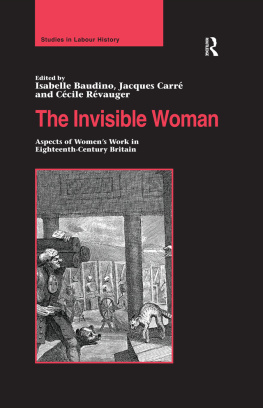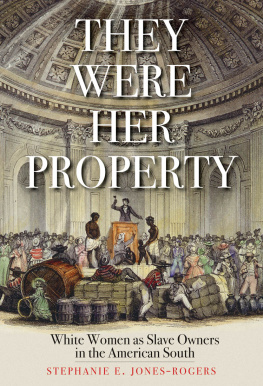Neither Lady nor Slave
2002 The University of North Carolina Press
All rights reserved. Manufactured in the United States of America
Designed by Heidi Perov
Set in Garamond MT and Linotype Zapfino by Keystone Typesetting, Inc.
The paper in this book meets the guidelines for permanence and durability of the Committee
on Production Guidelines for Book Longevity of the Council on Library Resources.
LIBRARY OF CONGRESS CATALOGING-IN-PUBLICATION DATA
Neither lady nor slave : working women of the Old South/
edited by Susanna Delfino and Michele Gillespie.
p. cm.
Includes bibliographical references and index.
ISBN 0-8078-2735-5 (cloth : alk. paper) isbn 0-8078-5410-7 (pbk.: alk. paper)
1. WomenSouthern StatesHistory19th century.
2. WomenEmploymentSouthern StatesHistory19th century.
3. Women employeesSouthern StatesHistory19th century.
4. Working class womenSouthern StatesHistory19th century.
I. Delfino, Susanna, 1949 II. Gillespie, Michele.
HQ 1438 .s 63 N 445 2002
305.4'0975' 09034dc21
2002003436
cloth 06 05 04 03 02 5 4 3 2 1
paper 06 05 04 03 02 5 4 3 2 1
Sarah H. Hill, Made by the Hands of Indians: Cherokee Women and Trade,
was originally published in slightly different form in Sarah H. Hill, Weaving New Worlds:
Southeastern Cherokee Women and Their Basketry (Chapel Hill, N.C.: University of
North Carolina Press, 1997). Used by permission of the publisher.
Stephanie McCurry, Producing Dependence: Women, Work, and Yeoman Households
in Low-Country South Carolina, was originally published in slightly different form in
Stephanie McCurry, Masters of Small Worlds: Yeoman Households, Gender Relations, and the
Political Culture of the Antebellum South Carolina Low Country (New York: Oxford
University Press, 1995). Used by permission of the publisher.
For Catherine Clinton
Nai non potemo aver perfetta vita senza amici
Contents
PART ONE
The Rural World and the Coming of the Market Economy
1. Dollars Never Fail to Melt their Hearts: Native Women and the Market Revolution
JAMES TAYLOR CARSON
2. Made by the Hands of Indians: Cherokee Women and Trade
SARAH H. HILL
3. Producing Dependence: Women, Work, and Yeoman Households in Low-Country South Carolina
STEPHANIE MCCURRY
PART TWO
Wage-Earning Women in the Urban South
4. A White Woman, of Middle Age, Would Be Preferred: Childrens Nurses in the Old South
STEPHANIE COLE
5. Spheres of Influence: Working White and Black Women in Antebellum Savannah
TIMOTHY J. LOCKLEY
6. Patient Laborers: Women at Work in the Formal Economy of West(ern) Virginia
BARBARA J. HOWE
PART THREE
Women as Unacknowledged Professionals
7. Depraved and Abandoned Women: Prostitution in Richmond, Virginia, across the Civil War
E. SUSAN BARBER
8. The Female Academy and Beyond: Three Mordecai Sisters at Work in the Old South
EMILY BINGHAM AND PENNY RICHARDS
9. Peculiar Professionals: The Financial Strategies of the New Orleans Ursulines
EMILY CLARK
10. Faith and Frugality in Antebellum Baltimore: The Economic Credo of the Oblate Sisters of Providence
DIANE BATTS MORROW
PART FOUR
Working Women in the Industrial South
11. I Cant Get My Bored on Them Old Lomes: Female Textile Workers in the Antebellum South
BESS BEATTY
12. To Harden a Ladys Hand: Gender Politics, Racial Realities, and Women Millworkers in Antebellum Georgia
MICHELE GILLESPIE
13. Invisible Woman: Female Labor in the Upper Souths Iron and Mining Industries
SUSANNA DELFINO
Tables
4.1. Defining Features of Cooks, House Servants, and Childrens Nurses in Advertisements for All Border Cities, 18001850
4.2. Ages of Cooks, House Servants, and Childrens Nurses in Advertisements by Status and with Standard Deviation for All Border Cities, 18001850
4.3. Distribution of Advertisements by Race and Status of Cooks for All Border Cities, 18001850
4.4. Distribution of Advertisements by Race and Status of House Servants for All Border Cities, 18001850
4.5. Distribution of Advertisements by Race and Status of Childrens Nurses for All Border Cities, 18001850
9.1. Convent Revenue Sources as Percentage of Total, 18201855
9.2. Convent Income Derived Directly from Slaves, 18201855
9.3. Slave Baptisms at Ursuline Chapel, 18351853
Neither Lady nor Slave
Introduction
We know too little about the lives of ordinary women in the Old South. We know even less about their working lives. Although the past two decades have witnessed an explosion of scholarship on southern women in the nineteenth century, much of this work has focused on the world of the plantation, where mistresses and slaves carried out an uneasy alliance under the eyes of the master. Womens historians began their inquiry into southern womens history by digging deeply into slaveholding womens lives, highlighting their subordination to husbands, fathers, and white men in general, even as they exposed the important benefits these women reaped by virtue of their class and race. More recently, equally exciting work has begun to appear on slave women. Much of this new research identifies the multiple hardships and tragedies slave women faced, even as it stresses the myriad ways these women established themselves as important historical actors.
Informed by these major developments in scholarship, Neither Lady nor Slave, a collection of thirteen essays, eleven of them original, two of them excerpted from award-winning books, pushes southern womens history in significant new directions by exploring ordinary womens working lives. The volume invites readers to rethink the conventional and limiting definition of worker as paid laborer (presumably in a factory). Although several of the essays examine women in these circumstances, many others deal with women whose work was unpaid even as they contributed substantially to their families incomes. Thus, their work was unacknowledged, owing to prevailing cultural attitudes about womens proper public image in relation to class and race as well as to the developing social construction of man as breadwinner that accompanied the market revolution. The invisibility of some types of female work in relation to existing social norms constitutes another central theme of this collection. In this regard, the essays present an amazingly wide set of combinations of paid versus unpaid and officially visible versus invisible womens work. These complexities illuminate key considerations about class, race, and ethnicity, which shaped ideas and standards of social acceptability about which women could perform what jobs in the Old South. The essays also highlight the centrality of womens roles in developing strategies toward achieving a balance between personal independenceas represented by their involvement in the market economyand the preservation of traditional spheres of authoritywhich only could be retained through service to their families and social respectability.
A sizable number of southern women performed jobs that were both paid and officially acknowledged. Their occupations, which ranged from those developing out of the gendered relegation of household duties (such as housekeeping, nursing, sewing, washing, and the like), to seamstressing for hire, to millwork, were traditionally deemed socially acceptable because of their cultural rooting in the pre-industrial economy. For this reason, they were not perceived as a threat to the existing male-dominated social order. However, womens agency again becomes apparent in these realms too. As this volume suggests, working womens actions in the slave South, as Victoria Bynums fine work has amply demonstrated, produced multiple patterns of resistance and rebellion; the most mature and articulate expressions of which in our volume are probably offered by the textile mill workers.



